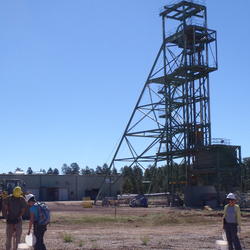Metals Exposure and Effects
Metals Exposure and Effects
Filter Total Items: 21
USGS Environmental Health Program: Integrating Science for Public Health and Resource Management
The USGS Environmental Health Program seeks to understand how environmental factors, especially contaminants and pathogens, influence human health and ecosystems. It focuses on studying the distribution and effects of toxic substances, environmental stressors, and their pathways. The program prioritizes collaboration with State, Federal and local governments; Tribes; non-government organizations...
Minerals Resources Life Cycle Integrated Science Team
The Minerals Resources Life Cycle Integrated Science Team focuses on contaminant exposures in the environment that might originate from mineral resource activities including, transportation, storage, extraction and waste management. Perceived health risks to humans and other organisms will be distinguished from actual risks, if any. If actual risks are identified the science produced by this team...
Human-Related Compounds in Water Sources in the Grand Canyon Help Identify Water Flow Pathways and Highlight Potential Water Quality Changes
U.S. Geological Survey (USGS) scientists investigated the movement of human-generated chemicals, such as pharmaceuticals and per- and polyfluorinated substances (PFAS), in groundwater along the South Rim of the Grand Canyon. This research led to a better understanding of the movement of wastewater into groundwater, of complex underground flow patterns, and of chemicals present in springs near...
Microbial Biogeochemistry Core Technology Team
About the Research The Microbial Biogeochemistry Laboratory Core Technology Team (CTT) as part of the Environmental Health Program focuses on environmental questions in aquatic systems (sediment and water) involving the linkages between major biogeochemical cycles (those involving carbon, sulfur, iron and nitrogen) and those associated with contaminants of concern.
Organic Geochemistry Research Core Technology Team
About the Research The Organic Geochemistry Research Laboratory Core Technology Team (CTT) as part of the Environmental Health Program works to develop targeted and non-targeted analytical methods for the identification and quantitation of chemicals that can impact the health of humans and other organisms, and uses bioassays to screen for receptor inhibition.
Bioaccumulation of Mercury in Fish Varied by Species and Location in the Chesapeake Bay Watershed—Summary of Existing Data and a Roadmap for Integrated Monitoring
Fish mercury data from State monitoring programs and research studies within the Chesapeake Bay were compiled and summarized to provide a comprehensive overview of the variation in fish mercury concentrations among species and habitats within the watershed. These data are put into context with existing health benchmarks for humans, birds, and fish. Scientists also provide a roadmap for an...
How are Mercury Sources Determined?
USGS scientists use innovative isotopic identification methods to determine mercury sources in air, water, sediments, and wildlife.
Food Web Changes Dampen Expected Reductions in Lake Trout Mercury Levels in Lake Michigan—Invasive Species Play Major Role
Combined analyses of mercury, nitrogen, and carbon isotopes in archived lake trout ( Salvelinus namaycush) tissues and sediment cores in Lake Michigan from 1978 to 2012 indicated that lake trout mercury concentrations mirrored declines in mercury sources prior to the arrival of invasive species that changed mercury transfer through the food and dampened the expected decreases in mercury...
Mercury Isotope Ratios used to Determine Sources of Mercury to Fish in Northeast U.S. Streams
Mercury isotope analyses were used to distinguish different sources of mercury to fish in 23 streams along a forested-rural to urban-industrial land-use gradient in the Northeastern United States. The use of mercury isotope measurements in fish tissue allow for distinguishing different sources of mercury that are bioaccumulating into the food web. Mercury isotope signatures in fish in forested...
Science to Help Understand Exposure and Toxicological Effects of Environmental Mercury to Representative Birds
Exposure and toxicity of environmental mercury to birds can be enhanced or lessened due to the available sources and forms of mercury and other species dependent factors such as life stage, migratory patterns, foraging and nesting behaviors, transfer of mercury from mothers to eggs, and sex. For example, mercury exposure can lead to sublethal toxicological effects that can influence parental...
Amphibians Exposed to Oil and Gas Co-Produced Wastewaters: Differentiating the Actual and the Perceived Inorganic Contaminant Hazards — Prairie Pothole Region
Chloride and metals in oil and gas co-produced wastewaters (often referred to as brines) are commonly perceived as contaminant hazards for biota. Amphibian abundance in the Prairie Pothole Region affected by historic oil and gas co-produced wastewaters was lower in wetlands with high concentrations of chloride indicating an actual contaminant hazard. Metals detected in sediments and amphibian...
Uranium in Springs Sampled Near the Grand Canyon Likely from Natural Sources
Scientists measured nine naturally occurring elements including uranium at 37 spring sites in the Grand Canyon area to establish baseline conditions and to understand the sources of uranium to local springs. Scientists found relatively greater concentrations of uranium at 6 of the 37 springs. A comprehensive geochemical analysis coupled with an understanding of the flow patterns in the area...













